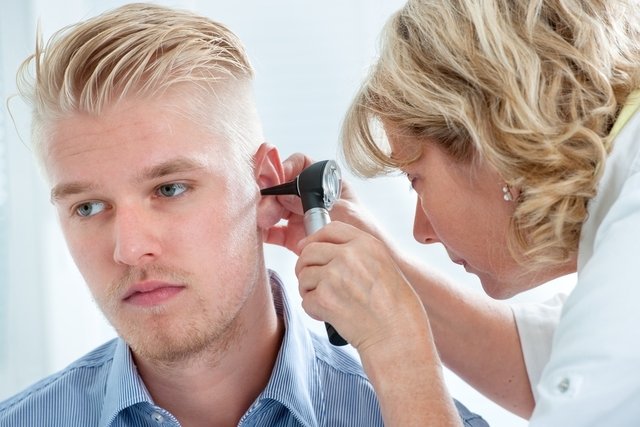When the eardrum is perforated, it is normal for a person to feel pain and itching in the ear, as well as having reduced hearing and even bleeding from the ear. Normally a small perforation heals on its own, but larger ones may require antibiotics, and when this is not enough, minor surgery may be necessary.
The eardrum, also called the tympanic membrane, is a membrane that separates the outer ear from the middle ear. It is important for hearing and when it is pierced, the person’s hearing capacity decreases and can lead, in the long term, to deafness, if not treated correctly.
Therefore, whenever you suspect a ruptured eardrum, or any other hearing disorder, it is important to consult an otorhinolaryngologist to identify the problem and begin the most appropriate treatment.

Perforated eardrum symptoms
The main symptoms of a perforated eardrum are:
- Intense ear pain that appears suddenly;
- Sudden loss of the ability to hear;
- Itching in the ear;
- Blood outflow from the ear;
- Pus in the ear, due to the presence of viruses or bacteria;
- Ringing in the ear;
- There may be fever, dizziness and vertigo.
It is recommended to go to the otorhinolaryngologist if there is a suspicion that the eardrum is perforated, especially if there are signs of infection such as discharge or bleeding, and whenever there is a significant reduction in hearing or deafness in one ear.
If you have symptoms of a perforated eardrum, make an appointment with an otolaryngologist in the nearest region:
Taking care of your health has never been easier!
How to confirm the diagnosis
The diagnosis of a perforated eardrum is made by an otorhinolaryngologist through the assessment of symptoms and a physical examination of the ear, using a special device, called an otoscope, which allows the tympanic membrane to be viewed, checking whether there is any type of hole.
In addition to checking to see if the eardrum is perforated, the doctor may also look for signs of infection which, if present, needs to be treated with antibiotics to allow the eardrum to heal.
Some tests may also be requested by the doctor, such as culture of ear secretion to check the type of bacteria that is causing the infection, audiometry or tympanometry, which allows the presence of secretion behind the eardrum to be assessed, for example.
Possible causes
The main causes of eardrum perforation are:
- Complication of ear infections, such as acute otitis media or otitis externa;
- Barotrauma, caused by sudden negative pressure during plane travel or diving;
- Head trauma;
- Acoustic trauma due to loud sounds or explosions;
- Introduction of objects into the ear, which especially affects babies and children, due to improper use of cotton swabs;
- Attempt to remove wax or foreign body from the ear.
In addition, perforation in the eardrum can also be caused by previous ear surgery, otitis media or severe otitis externa. Understand better what otitis is and the main types.
How the treatment is carried out
The treatment of a perforated eardrum must be carried out under the guidance of an otorhinolaryngologist, and it is recommended to keep the ear dry to prevent the emergence of an infection.
To do this, you can use a small piece of cotton inside your ear whenever you take a shower, and do not go to the beach or the pool. It is also recommended not to blow your nose and not wash your ears.
When there are signs of an ear infection or when the membrane has completely ruptured, the doctor may recommend the use of antibiotics such as neomycin or polymyxin with corticosteroid drops to drip into the affected ear.
In addition, the use of antibiotics in the form of tablets or syrups such as amoxicillin, amoxicillin + clavulanate and chloramphenicol may also be indicated, with the infection normally being fought within 8 to 10 days.
In some cases, tympanoplasty surgery may also be indicated to close the eardrum. Find out how tympanoplasty is performed and what recovery is like.
When surgery is indicated
Surgery to correct a perforated eardrum, also called tympanoplasty, is generally indicated when the membrane does not completely regenerate within 2 months of rupture.
Surgery is also indicated if, in addition to perforation, the person presents a fracture or compromise of the bones that form the ear, which is more common when there is an accident or head trauma, for example.
Bibliography
- THERAPY UPDATE. Tympanic Membrane Perforations. 2011. Disponível em: <https://hillsent.com.au/wp-content/uploads/2019/08/Tympanic-Membrane-Perforations-Update_Dr-Nirmal-Patel_article1.pdf>. Acesso em 17 jan 2020
- HARVARD HEALTH PUBLISHING. Perforated Eardrum. Disponível em: <https://www.health.harvard.edu/a_to_z/perforated-eardrum-a-to-z>. Acesso em 17 jan 2020
- NHS. Perforated eardrum. Available at: <https://www.nhs.uk/conditions/perforated-eardrum/>. Accessed on January 17, 2020

Sign up for our newsletter and stay up to date with exclusive news
that can transform your routine!
Warning: Undefined array key "title" in /home/storelat/public_html/wp-content/plugins/link-whisper-premium/templates/frontend/related-posts.php on line 12
Warning: Undefined array key "title_tag" in /home/storelat/public_html/wp-content/plugins/link-whisper-premium/templates/frontend/related-posts.php on line 13




